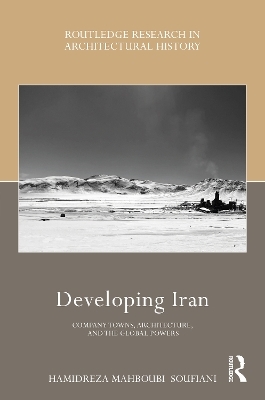
Developing Iran
Company Towns, Architecture, and the Global Powers
Seiten
2023
Routledge (Verlag)
978-1-032-43112-3 (ISBN)
Routledge (Verlag)
978-1-032-43112-3 (ISBN)
This book examines the emergence of modern company towns in Iran by delineating the architectural, political, and industrial histories of three resource-based ‘company town’ projects built during World War II. It will be of interest to researchers and students of architecture, history, international relations and Middle Eastern studies.
This book examines the emergence of modern company towns in Iran by delineating the architectural, political, and industrial histories of three distinct resource-based ‘company town’ projects built in association with the ‘Big Three’ powers of World War II.
The book’s narrative builds upon a tripartite research design that chronologically traces the formation and development of the oil, steel, and copper industries, respectively favoured by Great Britain, the Soviet Union, and the United States in this part of the world. By applying three sets of comparative studies, the book provides critical vantage points to three different ideological design paradigms: postcolonial regionalism, socialist universalism, and rationalist modern nation building. From a global political context, the book contributes to the disclosure of new information about the geopolitical confrontation of these three nations in the Global South to increase their sphere of influence after the Second World War. Furthermore, it demonstrates how postwar architectural modernism was adopted by each power and adapted to their ideological mind frame to fulfil distinct social, cultural, political, and economic targets.
This book examines multiple interconnections between architecture, politics, and industrial development by adopting a transdisciplinary approach based on comprehensive fieldwork, site surveys, and the analysis of original multilingual documents. As such, it will be of interest to researchers and students of architecture, history, international relations, and Middle Eastern studies.
This book examines the emergence of modern company towns in Iran by delineating the architectural, political, and industrial histories of three distinct resource-based ‘company town’ projects built in association with the ‘Big Three’ powers of World War II.
The book’s narrative builds upon a tripartite research design that chronologically traces the formation and development of the oil, steel, and copper industries, respectively favoured by Great Britain, the Soviet Union, and the United States in this part of the world. By applying three sets of comparative studies, the book provides critical vantage points to three different ideological design paradigms: postcolonial regionalism, socialist universalism, and rationalist modern nation building. From a global political context, the book contributes to the disclosure of new information about the geopolitical confrontation of these three nations in the Global South to increase their sphere of influence after the Second World War. Furthermore, it demonstrates how postwar architectural modernism was adopted by each power and adapted to their ideological mind frame to fulfil distinct social, cultural, political, and economic targets.
This book examines multiple interconnections between architecture, politics, and industrial development by adopting a transdisciplinary approach based on comprehensive fieldwork, site surveys, and the analysis of original multilingual documents. As such, it will be of interest to researchers and students of architecture, history, international relations, and Middle Eastern studies.
Hamidreza Mahboubi Soufiani is a researcher in architectural history based in Australia. He was awarded a master's of architecture and a PhD from the University of Western Australia.
Introduction Part 1: Oil Industry and the British Empire 1. Iran’s Oil Company Towns 2. Gachsaran Oil Company Town Part 2: Steel Industry and the Soviet Union 3. Arya Mehr Steel Complex 4. Aryashahr Steel Company Town Part 3: Copper Industry and the United States 5. Sarcheshmeh Copper Complex 6. Sarcheshmeh Copper Company Town
| Erscheinungsdatum | 24.10.2023 |
|---|---|
| Reihe/Serie | Routledge Research in Architectural History |
| Zusatzinfo | 32 Line drawings, black and white; 32 Halftones, black and white; 64 Illustrations, black and white |
| Verlagsort | London |
| Sprache | englisch |
| Maße | 156 x 234 mm |
| Gewicht | 571 g |
| Themenwelt | Geisteswissenschaften ► Geschichte ► Regional- / Ländergeschichte |
| Naturwissenschaften ► Biologie ► Ökologie / Naturschutz | |
| Naturwissenschaften ► Geowissenschaften ► Geografie / Kartografie | |
| Sozialwissenschaften ► Politik / Verwaltung | |
| Sozialwissenschaften ► Soziologie ► Spezielle Soziologien | |
| Technik ► Architektur | |
| ISBN-10 | 1-032-43112-1 / 1032431121 |
| ISBN-13 | 978-1-032-43112-3 / 9781032431123 |
| Zustand | Neuware |
| Haben Sie eine Frage zum Produkt? |
Mehr entdecken
aus dem Bereich
aus dem Bereich
Erinnerungen
Buch | Softcover (2024)
Pantheon (Verlag)
16,00 €
Universalgelehrter, Polarreisender, Entdecker
Buch | Hardcover (2024)
mareverlag
28,00 €


